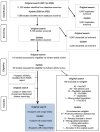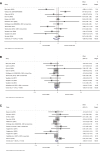Effectiveness of shared medical appointments delivered in primary care for improving health outcomes in patients with long-term conditions: a systematic review of randomised controlled trials
- PMID: 38453205
- PMCID: PMC10921542
- DOI: 10.1136/bmjopen-2022-067252
Effectiveness of shared medical appointments delivered in primary care for improving health outcomes in patients with long-term conditions: a systematic review of randomised controlled trials
Abstract
Objectives: To examine the effectiveness of shared medical appointments (SMAs) compared with one-to-one appointments in primary care for improving health outcomes and reducing demand on healthcare services by people with one or more long-term conditions (LTCs).
Design: A systematic review of the published literature.
Data sources: Six databases, including MEDLINE and Web of Science, were searched 2013-2023. Relevant pre-2013 trials identified by forward and backward citation searches of the included trials were included.
Eligibility criteria: Randomised controlled trials of SMAs delivered in a primary care setting involving adults over 18 years with one or more LTCs. Studies were excluded if the SMA did not include one-to-one patient-clinician time. All countries were eligible for inclusion.
Data extraction and synthesis: Data were extracted and outcomes narratively synthesised, meta-analysis was undertaken where possible.
Results: Twenty-nine unique trials were included. SMA models varied in terms of components, mode of delivery and target population. Most trials recruited patients with a single LTC, most commonly diabetes (n=16). There was substantial heterogeneity in outcome measures. Meta-analysis showed that participants in SMA groups had lower diastolic blood pressure than those in usual care (d=-0.086, 95% CI=-0.16 to -0.02, n=10) (p=0.014). No statistically significant differences were found across other outcomes. Compared with usual care, SMAs had no significant effect on healthcare service use. For example, no difference between SMAs and usual care was found for admissions to emergency departments at follow-up (d=-0.094, 95% CI=-0.27 to 0.08, n=6, p=0.289).
Conclusions: There was a little difference in the effectiveness of SMAs compared with usual care in terms of health outcomes or healthcare service use in the short-term (range 12 weeks to 24 months). To strengthen the evidence base, future studies should include a wider array of LTCs, standardised outcome measures and more details on SMA components to help inform economic evaluation.
Prospero registration number: CRD42020173084.
Keywords: Health policy; Organisation of health services; PRIMARY CARE.
© Author(s) (or their employer(s)) 2024. Re-use permitted under CC BY-NC. No commercial re-use. See rights and permissions. Published by BMJ.
Conflict of interest statement
Competing interests: None declared.
Figures



Similar articles
-
Behavioural modification interventions for medically unexplained symptoms in primary care: systematic reviews and economic evaluation.Health Technol Assess. 2020 Sep;24(46):1-490. doi: 10.3310/hta24460. Health Technol Assess. 2020. PMID: 32975190 Free PMC article.
-
Shared medical appointments in English primary care for long-term conditions: a qualitative study of the views and experiences of patients, primary care staff and other stakeholders.BMC Prim Care. 2022 Jul 20;23(1):180. doi: 10.1186/s12875-022-01790-z. BMC Prim Care. 2022. PMID: 35858833 Free PMC article.
-
Systematic reviews of the effectiveness of day care for people with severe mental disorders: (1) acute day hospital versus admission; (2) vocational rehabilitation; (3) day hospital versus outpatient care.Health Technol Assess. 2001;5(21):1-75. doi: 10.3310/hta5210. Health Technol Assess. 2001. PMID: 11532238 Review.
-
Beyond the black stump: rapid reviews of health research issues affecting regional, rural and remote Australia.Med J Aust. 2020 Dec;213 Suppl 11:S3-S32.e1. doi: 10.5694/mja2.50881. Med J Aust. 2020. PMID: 33314144
-
Patient-initiated appointment systems for adults with chronic conditions in secondary care.Cochrane Database Syst Rev. 2020 Apr 9;4(4):CD010763. doi: 10.1002/14651858.CD010763.pub2. Cochrane Database Syst Rev. 2020. PMID: 32271946 Free PMC article.
Cited by
-
Patient experiences with group consultations when treated with semaglutide for obesity: a qualitative case study in a Danish general practice.BMJ Open. 2025 Jul 25;15(7):e093357. doi: 10.1136/bmjopen-2024-093357. BMJ Open. 2025. PMID: 40713055 Free PMC article.
-
Self-Monitoring With Coping Skills and Lifestyle Education for Hypertension Control in Primary Care.J Clin Hypertens (Greenwich). 2024 Dec;26(12):1487-1501. doi: 10.1111/jch.14921. Epub 2024 Oct 22. J Clin Hypertens (Greenwich). 2024. PMID: 39437225 Free PMC article.
-
Continuous Glucose Monitors and Programmed Shared Medical Appointments in Managing Type 2 Diabetes Mellitus Among First Nation Women in Australia: A Co-Designed Feasibility Study.Am J Lifestyle Med. 2025 Jan 8:15598276241312084. doi: 10.1177/15598276241312084. Online ahead of print. Am J Lifestyle Med. 2025. PMID: 39802907 Free PMC article.
-
Acceptability and feasibility of shared medical appointments to support self-management of anxiety and depression in primary care in England: a qualitative study of service user/patient perspectives.BMJ Open. 2025 Jan 29;15(1):e080817. doi: 10.1136/bmjopen-2023-080817. BMJ Open. 2025. PMID: 39880451 Free PMC article.
References
-
- Clay H, Stern R. Making time in general practice: freeing GP capacity by reducing bureaucracy and avoidable consultations, managing the interface with hospitals and exploring new ways of working. 2015. Available: https://thehealthcreationalliance.org/wp-content/uploads/2018/11/Making-...
Publication types
MeSH terms
LinkOut - more resources
Full Text Sources
